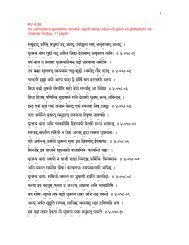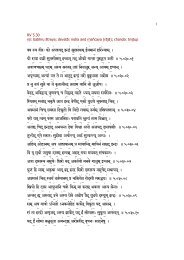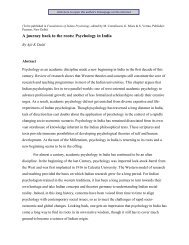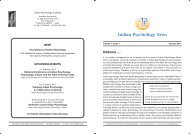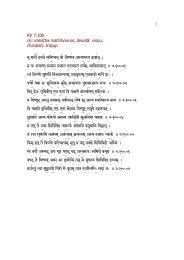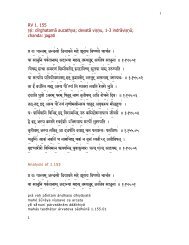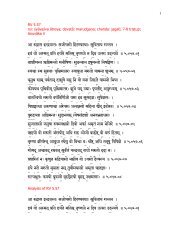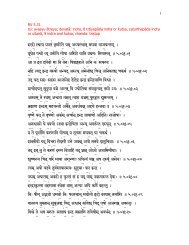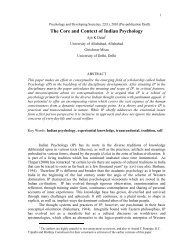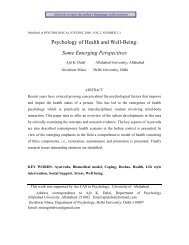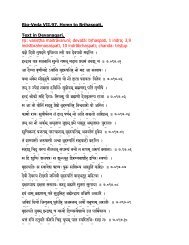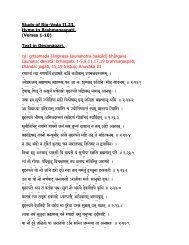Anasakti and health: A study of non-attachment - Indian Psychology ...
Anasakti and health: A study of non-attachment - Indian Psychology ...
Anasakti and health: A study of non-attachment - Indian Psychology ...
You also want an ePaper? Increase the reach of your titles
YUMPU automatically turns print PDFs into web optimized ePapers that Google loves.
90This <strong>study</strong> embodies transition <strong>of</strong> thoughts across distinct theoreticalframeworks. Concepts belonging to the domains <strong>of</strong> philosophy,mysticism <strong>and</strong> psychology have all been invoked with the aim <strong>of</strong>underst<strong>and</strong>ing the stress process. The seeming theoretical inconsistencymay be viewed as an initial step towards achieving adynamic synthesis <strong>of</strong> these different streams <strong>of</strong> knowledge.Although most indigenous systems are traditional, their interpretationin terms <strong>of</strong> contemporary language <strong>and</strong> vocabulary is adistinct possibility (Paranjpe, 1988). Since the process <strong>of</strong> indigenisationalso refers to indigenisation <strong>of</strong> research methodology,skepticism regarding the appropriateness <strong>of</strong> adopting empiricalmethods to underst<strong>and</strong> indigenous concepts which may not lendthemselves to their operationalistic orientation, is not unwarranted.Nonetheless, the decision to <strong>study</strong>ing indigenous concepts with thehelp <strong>of</strong> empirical methods can be taken. At astage where&dquo;...indigenisation has hardly passed beyond the embryonic stage <strong>of</strong>development...&dquo; (Ho, 1988, p. 54), this decision may be less appropriatebut more strategic. It may encourage the advocates <strong>of</strong>empiricism to look for concepts embedded in their own culturalheritage <strong>and</strong> in the process, it maysave those ancient texts frombeing subjected to the iconoclastic destruction by the present daynihilism, the &dquo;materialistic scientism&dquo; (Schumacher, 1977, p. 4).Before working out the implications <strong>of</strong> anasakti in the stressprocess, a brief description <strong>of</strong> the philosophical framework <strong>of</strong>anasakti will be presented here.According to almost every system <strong>of</strong> <strong>Indian</strong> philosophy, whetherorthodox or heterodox, realistic or idealistic, the purpose <strong>of</strong>human life is to achieve liberation from sufferings <strong>and</strong> realise theidentity <strong>of</strong> self with the Ultimate Reality. To be able to achieve thegoal <strong>of</strong> self-realisation, disengagement <strong>of</strong> consciousness fromdesires is necessary. Desires, which are directives <strong>of</strong> the senses,spring from the identification <strong>of</strong> self with the ego <strong>and</strong> its concerns<strong>of</strong> ambition, pride, <strong>attachment</strong> (asakti) <strong>and</strong> insistence on mineness(mamatva). For this <strong>study</strong>, description <strong>of</strong> anasakti given in theBhagvad Gitä was examined. The reason for selecting the BhagvadGitd over other sources was simple. The Bhagvad Gïtä describesanasakti in great thoroughness <strong>and</strong> works out the various conceivableramifications <strong>of</strong> the concept in all their details.In the Gita, the ideal <strong>of</strong> anasakti embodies the principles <strong>of</strong> spiritualismas well as exhortations to pragmatism <strong>and</strong> action orientation.Downloaded from pds.sagepub.com by Ajit Dalal on April 4, 2011
91<strong>Anasakti</strong> (the end state) has been explained in terms <strong>of</strong> anasaktaction or ’ni~kamakarma’ (which implies to achieve that end state).Anisakt action does not refer to physical abstention from activity.It is an intense, though disinterested action, performed with aspirit <strong>of</strong> dispassion, without nurturingconcerns about success orfailure, loss or gain, likes or dislikes. This results in a completeunification <strong>of</strong> the actor with the act <strong>and</strong> a consequent task excellence.According to the Bhagvad Gata, task excellence comesabout only when the . actor has understood that his concerns lieonly in actions <strong>and</strong> not in their results, that actions should notserve any personal motives <strong>and</strong> that these cognitions should notimply inaction. Being wedded to the piece <strong>of</strong> work at h<strong>and</strong> onlyimplies that while an individual is at work, he is not allowing hisabilities to run to waste in mental preoccupations <strong>and</strong> fears pertaining tothe results <strong>and</strong> consequences. Such an attitude towards work significantlyaffects the emotional response to success <strong>and</strong> failure.Following the relinquishment <strong>of</strong> desires, mental serenity is acquired<strong>and</strong> the individual maintains greater emotional equipoise in theface <strong>of</strong> consequence, be it good br bad, desirable or undesirable.In other words, by way <strong>of</strong> recominending commitment <strong>and</strong>total absorption in the task, the doctrine <strong>of</strong> anasakt action <strong>of</strong>fersan excellent way by which our worldly endeavours can becomemore effective.Although anasakti is extolled as an ideal by the <strong>Indian</strong> philosophical<strong>and</strong> mystical literature, yet it is manifested through commoncultural expressions such as popular songs, idioms, phrase <strong>and</strong>folklores. Depending upon the variety <strong>and</strong> breadth <strong>of</strong> their exposureto this ideal, people manifest anasakti in their day-to-day liveswithout perhaps being aware <strong>of</strong> its underlying metaphysical meaning.Since personality dispositions are partly conditioned by the dominantinputs contained in a given culture, anasakti is conceptualised as amultifaceted personality construct consisting <strong>of</strong> a set <strong>of</strong> beliefs,attitudes <strong>and</strong> cognitions consistent with the essence <strong>of</strong> the ideal.The causal linkage between anasakti <strong>and</strong> <strong>health</strong> can now beexplicated. It can be argued that the doctrine <strong>of</strong> anasakt actionconveys ,a message which is central to coping with life stressors.This argument is based on the psychological literature whichdemonstrates the significance <strong>of</strong> cognitive <strong>and</strong> attitudinalsystems in determining the manner in which stress inducingsituations are confronted (Pearlin, Liberman, Menaghan, &Mullan, 1981).Downloaded from pds.sagepub.com by Ajit Dalal on April 4, 2011
92/The distinctive characteristics <strong>of</strong> anasakti are effort orientation,emotional equipoise in the face <strong>of</strong> success <strong>and</strong> failure, a relativelyweak concern for obtaining extrinsic rewards, <strong>and</strong> an intense effortto achieve excellence. Therefore, those high on anasakti areexpected to experience lesser distress <strong>and</strong> exhibit fewer symptoms<strong>of</strong> strain. These arguments will be extended on the basis <strong>of</strong> conjectures<strong>and</strong> empirical evidence.Frankl (1963) stated that people engage in an active search formeaning even in their sufferings. While <strong>study</strong>ing the nature <strong>of</strong>stressors <strong>and</strong> coping strategies <strong>of</strong> the physically h<strong>and</strong>icappedchildren, Srivastava ’(1981) noted that in spite <strong>of</strong> the variousdisadvantages that the physically h<strong>and</strong>icapped children face,they still view their own condition <strong>and</strong> that <strong>of</strong> their fellow beingsmore positively. It is also seen that commitment to some highergoal in life enables people to meaningfully reconstruct eventhose experiences which can be described as damaging. In thelight <strong>of</strong> these facts, anasakt action seems to <strong>of</strong>fer an importantcoping resource. It may be reaffirmed here that anasakt action isnot without a goal, rather it has a very definite goal-the goal <strong>of</strong>self-realisation. In performing actions in an anasakt manner, themore familiar <strong>and</strong> common goalsare subordinated to the lessfamiliar <strong>and</strong> less common ones. This results in recognising thespiritual value <strong>of</strong> action in addition to its material significance.If the goal is fixed inwards, the emotional impacts <strong>of</strong> externalsuccess <strong>and</strong> failure are minimised. Once this happens, theconsequences-good or bad-will be cognised as milestoiles inthe path to self-realisation rather than as reflections <strong>of</strong> personalcapabilities.One who has been able to relieve himself <strong>of</strong> the anxieties pertainingto success or failure can apply himself to any task moreeffectively as compared to others. An anasakt person would perhapsbe more effective in pursuing material goals also. For example, astudent high on anasakti, will not let the anxieties about success orfailure distract him when he is preparing for the examination. Theenergy thus conserved, would be directed to the task at h<strong>and</strong> <strong>and</strong>,therefore, he would be able to perform his task with reasonableexcellence. Since outcome concerns do not govern his actions, hewould be able to maintain greater emotional equipoise in the face<strong>of</strong> success or failure <strong>and</strong> evaluate the causes <strong>of</strong> his failure moredispassionately.Downloaded from pds.sagepub.com by Ajit Dalal on April 4, 2011
’These conjectures have empirical support. Zaffy <strong>and</strong> Bruning(1966) have suggested that anxiety causes individuals to attend t<strong>of</strong>ewer cues in solving a problem. Easterbrook (1959) has statedthat the number <strong>of</strong> cues utilised in any situation tends to becomesmaller with increase in emotion. This emotional arousal getsexaggerated when the individual starts ruminating about thoseideas which may be totally irrelevant to the task, such as, hispsychological state. As a consequence, the individual starts attendingto the autonomic activity which is thus generated only to showpoorer task performance (M<strong>and</strong>ler, 1982).Brown (1980) has argued that while reacting to stressors, certainkinds <strong>of</strong> intellectual processes form asequence93to exacerbatedistress. They refer to the manner in which an individual interpretsthe disparity between his expectations <strong>and</strong> perception <strong>of</strong> an event.This interpretation might lead to various kinds <strong>of</strong> perceptualdistortions, unconscious defenses <strong>and</strong> attentional problems. Thoits(1984) has pointed out that emotions have a major role in thestress process <strong>and</strong> that the techniques adopted for exnotion managementcan alter the perception <strong>of</strong> stressors as well as coping.strategies.Since these intrusive cognitions <strong>and</strong> emotional excitations arecrucial in the reaction to stressors, it can be argued that greaterconcentration <strong>and</strong> absorption in the task at h<strong>and</strong> will eliminateabout the nature <strong>of</strong>task-irrelevant thoughts such as anticipationsoutcomes. This will perhaps result in task excellence. On the otherh<strong>and</strong>, emotional stability acquired through mentally dissociatingoneself from the outcome will protect the individual from emotionallysuccumbing to the experience <strong>of</strong> failure. Therefore it seemsthat anasakti will help the individual in such a way that he does notperceive life events as stressors. It may also serve as a significant&dquo;resistance resource&dquo; (Antonovsky, 1980) <strong>and</strong> increase his physical<strong>and</strong> psychological resistance to distress.The following hypotheses were formulated for this <strong>study</strong>.In the case <strong>of</strong> subjects high on anasakti comparedon it:1. The mean <strong>of</strong> distress ratings given.to those lowin stressful life eventswould be smaller.2. The mean <strong>of</strong> strain scores would be smaller.Downloaded from pds.sagepub.com by Ajit Dalal on April 4, 2011
__94Method <strong>and</strong> ProcedureSampleThe data were collected on 465 adults in the age range <strong>of</strong> 30-50years with minimum education up to matriculation level. Of thesesubjects, 230 were males <strong>and</strong> 235 were females. The males representedvarious pr<strong>of</strong>essional groups such as doctors, engineers,lawyers, businessmen as well as those employed in public sectorundertakings. The meanage <strong>of</strong> males <strong>and</strong> females were 38.14 <strong>and</strong>32.44 years, respectively.InstrumentsThe Measure <strong>of</strong> <strong>Anasakti</strong>. A scale measuring anasakti was developedto assess the degree to which people show anasakti in theconduct <strong>of</strong> their daily lives. The scale (in Hindi) consisted <strong>of</strong> 28items which were based on the description <strong>of</strong> &dquo;sthitaprajna&dquo; (aman <strong>of</strong> steady wisdom) given in the Bhagvad Gïtä. These itemswere related to five factors <strong>of</strong> anasakti. These factors were: OutcomeAttachment, Effort Orientation, Endurance <strong>and</strong>Vulnerability,Equipoise; <strong>and</strong> Physical-Sensual Non-identification. Subjects wereasked to report the extent to which behaviour described undereach item was applicableto them on a 5-point rating scale rangingfrom 1 (not at all applicable) to 5 (entirely applicable). Theminimum <strong>and</strong> maximum anasakti scores were 28 <strong>and</strong> 140, respectively.Details relating to the construction <strong>of</strong> this scale are reportedelsewhere (P<strong>and</strong>e, 1990).The Measure <strong>of</strong> Stress.1’he stress scale used in this <strong>study</strong> included76 items which covered major events as’ well as minor ongoinghassles. These items were grouped in the following categories <strong>of</strong>stressors: Stressful Events, Ongoing Stressors, Financial, Health<strong>of</strong> Others, Bereavement, Work/Occupational, Interpersonal, Ego,Family, Separation, Personal Setbacks, <strong>and</strong> Major Changes. Subjectswere required to report events during the past one year. A 5-pointrating scale was provided for each item. Subjects used this scale toindicate the extent to which they had experienced distress when a/Downloaded from pds.sagepub.com by Ajit Dalal on April 4, 2011
given event occurred in their lives. The scale points were 1 (nodistress at all), 2 (a little distress), 3 (average distress). 4 (muchdistress), <strong>and</strong> 5 (too much <strong>of</strong> distress).The Measure <strong>of</strong> Strain. A symptom checklist-cum-rating scale toassess ill <strong>health</strong> was used. The scale comprised 45 items; some <strong>of</strong>these items were taken from a <strong>health</strong> scale constructed by Caplan,Naidu <strong>and</strong> Tripathi (1984), while others were framed to assess themental <strong>and</strong> psychological <strong>health</strong> <strong>of</strong> subjects. These items wererelated to nine factors <strong>of</strong> strain which were: Depression, PhysicalVitality, Positive State, Self-Image, Anger, Digestion, Flu, Sleep-Lethargy, <strong>and</strong> Inadequacy. Subjects were asked to indicate on a4-point rating scale, how <strong>of</strong>ten they had experienced each <strong>of</strong> thesymptoms in the past two weeks. The scale points were,: 1 (did nothapperi at all), 2. (happened on a few occasions), 3 (happenedmany times), <strong>and</strong> 4 (continued for almost all the time). Theminimum <strong>and</strong> maximum strain scores were 455 <strong>and</strong> 180, respectively.95Computation <strong>of</strong> Anisakti, Stress <strong>and</strong> Strain ScoresAnisakti scores were obtained by summating the ratings givenby the subjects to all 28 items <strong>of</strong> the scale <strong>of</strong> anasakti. Reversescoring was done for items which were negatively rated.For each subject, three stress scores were computed. TheSimple Stress Score (SSS) was obtained by counting the number <strong>of</strong>stressful life events experienced by the subject. Of the three stressscores, this was the most objective score <strong>of</strong> stress. The WeightedStress Score (WSS) was obtained by summating the distress ratingsgiven by the subject to the events which he/she had experienced.This score was a function <strong>of</strong> both the objective count <strong>of</strong> events <strong>and</strong>subjectively perceived intensity <strong>of</strong> distress. It was a compositescore <strong>of</strong> both the environmental event <strong>and</strong> subjective perception.The Average Distress Rating (ADR) was obtained by dividing theWSS by the number <strong>of</strong> events experienced or SSS. It yielded ameasure <strong>of</strong> the average amount <strong>of</strong> subjectively perceived distress acrossthe endorsed items. Of the three stress scores, this was the mostsubjective score, the purest measure <strong>of</strong> subjectively perceived distress.The strain score <strong>of</strong> each subject was derived by summating theratings which he/she gave to 45 strain symptoms included in the-Downloaded from pds.sagepub.com by Ajit Dalal on April 4, 2011
96strain measure. Reverse scoringthe subject’s well-being.was done for items indicative <strong>of</strong>,ResultsThis paper reportsapart <strong>of</strong> the data <strong>of</strong> a larger <strong>study</strong> whichinvestigated the moderator role <strong>of</strong> anasakti in the stress process.In this section, data pertaining to the correlation between themeasures <strong>of</strong> stress, strain <strong>and</strong> anasakti, comparison <strong>of</strong> the means<strong>of</strong> these variables <strong>of</strong> two extreme anasakti groups <strong>and</strong> the identification<strong>of</strong> predictors <strong>of</strong> strain will be presented.Correlations between Stress, <strong>Anasakti</strong> <strong>and</strong> Strain ,’Correlations were computed between stress, anasakti <strong>and</strong> strainscores. The coefficients <strong>of</strong> correlation between SSS, WSS ADR,anasakti <strong>and</strong> strain have been presented in Table 1.Table 1Coefficients <strong>of</strong> Correlation between SSS, WSS, ADR, Anisakti <strong>and</strong> Strainn = 465Note: SSS is Simple Stress Score; WSS is Weighted Stress Score; ADR is AverageDistress Rating; AS is <strong>Anasakti</strong>; vvp< .0 1.The three stress scores, i.e., SSS, WSS <strong>and</strong> ADR were correlatedpositively with each other. Subjects who encountered greaternumber <strong>of</strong> stressful life events, gave higher distress ratings <strong>and</strong> onanaverage felt more distressed. A very highcorrelation betweenSSS <strong>and</strong> WSS (r = .94) was obtained because the computation <strong>of</strong>WSS was dependent upon SSS, WSS or the sum <strong>of</strong> distress ratingsDownloaded from pds.sagepub.com by Ajit Dalal on April 4, 2011
_’’’<strong>of</strong> events endorsed constituted SSS. In comparison to the correlationbetween SSS <strong>and</strong> ADR (r = .22), a higher correlation was obtainedbetween WSS <strong>and</strong> ADR (r = .46) because both WSS <strong>and</strong> ADR wererelated to the perception <strong>of</strong> distress.<strong>Anasakti</strong> was significantly correlated with WSS <strong>and</strong> ADR butnot with SSS. This implied that a higher degree <strong>of</strong> anasakti wasrelated to the perception <strong>of</strong> lower distress. Compared to the threestress scores, anasakti had the highest correlation with strain.In order to make comparisons between SSS, WSS, ADR <strong>and</strong>strain scores <strong>of</strong> subjects who were high <strong>and</strong> low on anasakti, criteriongroups <strong>of</strong> anasakti were identified. Subjects whose anasakti scoreswere below 104 (30th percentile <strong>of</strong> the frequency distribution <strong>of</strong>anasakti scores) were included in the low anasakti group <strong>and</strong> thosewho had scored above 118 (70th percentile) were included in thehigh anasakti group.’97Significance <strong>of</strong> Difference between Means <strong>of</strong>Stress <strong>and</strong> Strain Scores <strong>of</strong> Criterion GroupsMeans <strong>of</strong> SSS, WSS, ADR <strong>and</strong> strain scores were derived for high<strong>and</strong> low anasakti groups <strong>and</strong> significance <strong>of</strong> difference betweenmeans was tested.Table 2Means <strong>of</strong> SSS, WSS, ADR <strong>and</strong> Strain Scores <strong>of</strong> the Criterion GroupsThe analysis revealed that the two groupswere almost identicalon mean SSS <strong>and</strong> there was a <strong>non</strong>-significant difference betweenthe means <strong>of</strong> WSS <strong>of</strong> the twogroups in the expected direction.Thus WSS failed to reveal a significant difference probably becauseit was very highly correlated with SSS. The <strong>non</strong>-significant differenceDownloaded from pds.sagepub.com by Ajit Dalal on April 4, 2011
98/was perhaps a weak pointer towards differences in the manner inwhich these two groups perceived life events. This feature wasbrought out more clearly in ADR which was a purer measure <strong>of</strong>the perception <strong>of</strong> distress. ADR was significantly lower in the case<strong>of</strong> subjects who were high on anasakti compared to those whowere low on it.The capacity <strong>of</strong> the high anasakt group to cope with stressors<strong>and</strong> experience less distress was reflected in the process <strong>of</strong> somatisationalso. Subjects high on anasakti exhibited fewer symptoms <strong>of</strong>strain compared-to those who were low on anasakti.Identifying Predictors <strong>of</strong> Strain -{A simultaneous multiple regression analysiswas done to determinethe relative significance <strong>of</strong> anasakti <strong>and</strong> stress scores in predictingstrain. Since SSS <strong>and</strong> WSS were strongly correlated (r=.94) onlyWSS was entered in the regression equation along with ADR <strong>and</strong>-anasakti.Table 3Multiple Regression Analysis for Total Sample: Anásakti, WSS <strong>and</strong> ADR asindependent Variables, Strain as Dependent VariableNote ’°‘p
’99DiscussionThe concept <strong>of</strong> anasakti in the spiritual lore means progressivedetachment <strong>of</strong> consciousness from the psycho-physical apparatus.Patanjali’s <strong>and</strong> Shankaracharya’s systems envisage five stages <strong>of</strong>development <strong>of</strong> consciousness <strong>of</strong> one who is pursuing the spiritualgoal. These five stagesare termed &dquo;Panchakosha&dquo; or five sheathsSwami Ajay, 1976). The concept <strong>of</strong>(Swami Ram, Ballentine, &&dquo;panchakosha&dquo; has a logical consequence for psychology. Tounderst<strong>and</strong> the experience <strong>and</strong> behayiour <strong>of</strong> people in the fivedifferent &dquo;kosha&dquo;, different psychologiesare needed.Most people belong to the &dquo;manomayakosha&dquo; which is the middlelevel <strong>of</strong> the five hierarchical stages <strong>of</strong> development. The -&dquo;manomayakosha&dquo; refers to the mental level including the lower<strong>and</strong> higher minds. The lower mind or &dquo;manas&dquo; serves to coordinatesensory input <strong>and</strong> motor output after the higher mind, the &dquo;buddhi&dquo;has adjudged the meaning <strong>of</strong> the incoming sensory information<strong>and</strong> has decided on the course <strong>of</strong> action to be taken.The &dquo;manomayakosha&dquo; is a wide b<strong>and</strong>. ThQse who are primarilyat the level <strong>of</strong> &dquo;manas&dquo; would exhibit impulsivity <strong>and</strong> a strongtendency to seek pleasure. Those who are primarily at the level <strong>of</strong>&dquo;buddhi&dquo; would be more discriminating. Therefore this &dquo;kosha~~~represents a stage <strong>of</strong> intellectually controlled emotionality; a stagewhere cognitive structures exert controlling influence on emotions.Modern psychological theories which have relevance within theframework <strong>of</strong> &dquo;manomayakosha&dquo; are cognitive theories <strong>of</strong> stress(Lazarus, 1975; Rosenbaum, 1988).One <strong>of</strong> the aims <strong>of</strong> this <strong>study</strong> was to demonstrate the possibility<strong>of</strong> conceptual bridges between disparate paradigms. Therefore,the findings <strong>of</strong> this <strong>study</strong> will be interpreted in terms <strong>of</strong> the cognitivetheories <strong>of</strong> stress.Anisakti, Perception<strong>of</strong> Distress <strong>and</strong> StrainThe most significant finding which emerged from this <strong>study</strong>concerned the perception <strong>of</strong> distress in stressful life events. It wasfound that subjects high on anasakti did not significantly differfrom those low on anasakti in terms <strong>of</strong> the number <strong>of</strong> life eventsDownloaded from pds.sagepub.com by Ajit Dalal on April 4, 2011
100/which had occurred in their lives (SSS). When the number <strong>of</strong> eventswhich they had experienced was controlled, the average subjectiveperception <strong>of</strong> distress (ADR) was significantly lower for subjectswho were high on anasakti. The tendency to experience less distressin general, helped the more anasakti subjects to maintain superiorphysical <strong>and</strong> psychological <strong>health</strong> comparedon anasakti.Stress isto those who were lowa multi-dimensional concept which necessitates an<strong>of</strong> ;ts personal <strong>and</strong> environmental antecedents.underst<strong>and</strong>ingLazarus (1975) has emphasised the significance <strong>of</strong> threat appraisalsiri the perception <strong>of</strong> distress in negative life events. Anotherimportant facet <strong>of</strong> appraisal refers to the meaning which is assignedto those events. Negative life events can be more deleterious ifthey are perceived to be central to one’s existence, are consideredto be stable <strong>and</strong> are attributed to global causes (Metalsky,Halberstadt, & Abramson, 1987).These psychological interpretive mechanisms are crucial indetermining the emotional reactions to stressful life events.Depending upon whether the situation is interpreted as harmful,beneficial, threatening or challenging, an individual experiencespositive or negative emotions. The interpretation <strong>of</strong> a situation asinvolving harm or threat generates such affective states as anxiety,nervousness, tension <strong>and</strong> anger. The affective states, which maybe the most ubiquitous emotional reactions to situations which areappraised as stressful, interfere with cognitive functioning <strong>and</strong>with coping (Schwarzer, 1984). Two mechanisms <strong>of</strong> interferencehave been emphasised. First, a motivational one in which attention isdiverted from the task at h<strong>and</strong> to more pressing emotional crisiswhich is perceived to be associated with a situation (Sch6npflug,1983), <strong>and</strong> second, a cognitiveone in which anxiety related thoughts,which may be unrelated to performance, are nurtured. If, however, asituation is interpreted as presenting challenges rather than threats,more positive emotions are experienced leading to effective coping.Folkman <strong>and</strong> Lazarus (1988) have suggested that on certainoccasions, focusing on the problem which is causing distress maylead to an improved emotional state. They refer to focusingon theproblem as planful problem solving. According to them, planfulproblem solving results in an improv ed person-environment relationleading to a favourable cognitive appraisal <strong>and</strong>, therefore, to amore positive emotional response.Downloaded from pds.sagepub.com by Ajit Dalal on April 4, 2011
101Within this framework, the findings relating to the perception <strong>of</strong>distress can be interpreted. As stated earlier, subjects high <strong>and</strong> lowon anasa.4ti differed from each other with respectto their subjectiveperception <strong>of</strong> distress (ADR) <strong>and</strong> symptoms <strong>of</strong> strain. Since anasaktiis characterised by a strong tendency toward effort orientation, thosehigh on anasakti were able to evoke action-oriented self-regulatoryprocesses more effectively than those who were low on anasakti.Self-regulatory processes consist <strong>of</strong> three phases (Rosenbaum,1988). When stressful situations are encountered, these phasesinvolve representation, evaluation <strong>and</strong> action. In the representationphase, the individual reacts emotionally <strong>and</strong>/or cognitively tostressors which cause disruption in his daily routine. In the evaluationphase, he evaluates the significance <strong>of</strong> disruption caused bystressors in terms <strong>of</strong> his well-being. In the action phase, he respondsto stressors in such a way that the disruption may be minimised.Significant mean differences in ADR suggested that individualshigh <strong>and</strong> low on anasakti differed from each other in the manner inwhich stressors were represented. When they confronted stressfullife events, they felt differentially distressed. <strong>Anasakti</strong> helped thehigher anasakti group to evaluate stressful events as presentingchallenges rather than threats. They could evolve suitable copingstrategies because <strong>of</strong> their disposition to remain emotionally poised.In the case <strong>of</strong> subjects low on anasakti, threat appraisals, emotionalinstabilities <strong>and</strong> coping ineptitudes may have led to greater perceiveddistress. These individuals also manifested moresymptoms <strong>of</strong>psychological <strong>and</strong> physical ill <strong>health</strong>. ,<strong>Anasakti</strong>: The Predictor <strong>of</strong> StrainThe relative significance <strong>of</strong> anasakti <strong>and</strong> stress scores in predictingstrain was tested. More than the stress scores, anasakti significantlypredicted strain symptoms. This finding suggested that dispositionalfactors increased an individual’s susceptibility to stressors morethan the situation itself. <strong>Anasakti</strong> was found to representone facet<strong>of</strong> human personality which helped individuals remain well adjusted<strong>and</strong> <strong>health</strong>y despite exposure to’ stressors. It was also found thatthe contribution <strong>of</strong> anasakti in predicting strain was greater thanthe contribution <strong>of</strong> stress scores. The psychological processesunderlying this finding will be discussed.Downloaded from pds.sagepub.com by Ajit Dalal on April 4, 2011
102/As stated earlier, anasakti refers to an end state <strong>and</strong> also ameans to achieve that end state. The end state is that <strong>of</strong> selfrealisationwhich can be gradually approached through the performance<strong>of</strong> actions without <strong>attachment</strong> to their consequences,. Onewho has achieved this end state, &dquo;the siddha&dquo;, becomes spontaneouslyanasakt by terminating his identity with the &dquo;empirical self&dquo; (Tart,1975).’ He enjoys a state <strong>of</strong> pr<strong>of</strong>ound peace which cannot be alteredby any crisis. One who aspires to achieve that state, &dquo;the sadhaka&dquo;,remains in peace because he voluntarily relinquishes all egoisticaldesires <strong>and</strong> practises anasakti as a means to achieve his goal.Even the western literature on stress admits that perceptionregarding thwarting <strong>of</strong> desires constitutes major category <strong>of</strong> stressors<strong>and</strong> presents potential dangers to an individual’s well-being.Housten (1987) has defined desires as longing for something whichone does not have <strong>and</strong> keeping something which one already has.Desires emanate from <strong>attachment</strong>. Individuals experience distresswhen their <strong>attachment</strong> to people or things is threatened. Strongerthe <strong>attachment</strong>, greater is the desire to protect <strong>and</strong> preserve <strong>and</strong>higher will be the feeling <strong>of</strong> agitation if that desire is thwarted.Coping with negative life events is influenced byan individual’s&dquo;assumptive world&dquo; (Parkes, 1975). This world consists <strong>of</strong> hisstrongly held assumptions about the world <strong>and</strong> about his own self.Epstein (1984) has asserted that an individual’s personal theoryabout reality acts as a conceptual tool for solving life’s fundamentalproblems: According to him, this theory incorporates a worldtheory <strong>and</strong> a theory regarding self. It may not exist in his consciousawareness but as a preconscious conceptual system, it may structurehis experiences <strong>and</strong> direct his behaviour. Implicit in the ideal <strong>of</strong>anasakti is a world view. in which self-realisation is considered tobe the goal <strong>of</strong> human life <strong>and</strong> identification <strong>of</strong> self with the material<strong>of</strong> self-realisation.world to be a major impediment in the pathThis world view perhaps helped people in changing the perception<strong>of</strong> life events from stressful to benign, reducing egotism fromstrivings <strong>and</strong> hence s<strong>of</strong>tening the impact <strong>of</strong> many stressors.REFERENCESANTONOVSKY, A. (1980). A call for the <strong>study</strong> <strong>of</strong> salutogenesis. Paper preparedfor the National Academy <strong>of</strong> Sciences, Ben-Gurion University <strong>of</strong> the Negev,Beersheba, Israel.Downloaded from pds.sagepub.com by Ajit Dalal on April 4, 2011
103BROWN, B.B. (1980). Perspectives on social stress. In H. Selye (Ed.), Selyeguide to stress research, 1. New York: Van Nostr<strong>and</strong> Reinhold.CAPLAN, R.D., NAIDU, R.K., & TRIPATHI, R.C. (1984). Coping <strong>and</strong>defending: Constellations versuscomponents. Journal <strong>of</strong> Health <strong>and</strong> SocialBehaviour, 25, 303-320.EASTERBROOK, J.A. (1959). The effect <strong>of</strong> emotion on cue utilization <strong>and</strong> theorganization <strong>of</strong> behavior. Psychological Review, 66, 183-201.EPSTEIN, S. (1984). Controversial issue in emotion theory. In P. Shaver (Ed.),Review <strong>of</strong> personality <strong>and</strong> social psychology: Emotions, relationships <strong>and</strong><strong>health</strong>. Beverly Hills, CA: Sage Publications.FOLKMAN, S., & LAZARUS, R.S. (1988). Coping as a mediator <strong>of</strong> emotion.Journal <strong>of</strong> Personality <strong>and</strong> Social <strong>Psychology</strong>, 54, 466-475.FRANKL, V.E. (1963). Man’s search for meaning. An introduction to logotherapy.New York: Washington Square Press.HO, D.Y.F. (1988). Asian psychology: A dialogue on indigenization <strong>and</strong> beyond.In A.C. Paranjpe, D.Y.F. Ho & R.W. Reiber (Eds.), Asian contributions topsychology, N.Y.: Praeger.HOUSTEN, B.K. (1987). Stress <strong>and</strong> coping. In C.R. Snyder & C.E. Ford (Eds.),Coping with negative life events: Clinical <strong>and</strong> social psychological perspectives.New York: Plenum Press.LAZARUS, R.S. (1975). A cognitively oriented psychologist looks at bi<strong>of</strong>eedback.American Psychologist, 30, 553-561.MANDLER, G. (1982). Stress <strong>and</strong> thought processes. In L. Goldberger &S. Breznitz (Eds.), H<strong>and</strong>book <strong>of</strong> stress: Theoretical <strong>and</strong> clinical aspects. NewYork: Free Press.METALSKY, G.I., HALBERSTADT, L.J., & ABRAMSON, L.Y. (1987).Vulnerability to depressive mood reactions: Toward a more powerful test <strong>of</strong>the diathesis-stress <strong>and</strong> causal mediation components <strong>of</strong> the reformulatedtheory <strong>of</strong> depression. Journal <strong>of</strong> Personality <strong>and</strong> Social <strong>Psychology</strong>, 52,386-393.PANDE, N. (1990). Studies on differential vulnerability to stress: The impact <strong>of</strong>detachment on <strong>health</strong>. Unpublished doctoral dissertation, University <strong>of</strong>Allahabad, Allahabad.PARANJPE, A.C. (1988). Introduction, In A:C. Paranjpe, D.Y.F. Ho, & R.W.Reiber (Eds.), Asian contributions to psychology. New York: Praeger.PARKES, C.M. (1975). What becomes <strong>of</strong> redundant world models. A contributionto the <strong>study</strong> <strong>of</strong> adaptation to change. British Journal <strong>of</strong> Medical <strong>Psychology</strong>, 48,131-137.PEARLIN, L.T., LIBERMAN, M.A., MENAGHAN, E.G., & MULLAN,J.T. (1981). The stress process. Journal <strong>of</strong> Health <strong>and</strong> Social Behaviour, 22,337-356.ROSENBAUM, M. (1988). Learned resourcefulness, stress <strong>and</strong> self-regulation.In S. Fisher & J. Reason (Eds.), H<strong>and</strong>book <strong>of</strong> life stress cognition <strong>and</strong> <strong>health</strong>.New York: Wiley.SCHONPFLUG, W. (1983). Coping efficiency <strong>and</strong> situational dem<strong>and</strong>s. InG.R.J. Hockey (Ed.), Stress <strong>and</strong> fatigue in human performance. New York:Wiley.SCHUMACHER, E.F. (1977). A guide for the perplexed. New York: Harper & Row.Downloaded from pds.sagepub.com by Ajit Dalal on April 4, 2011
104SCHWARZER, R. (Ed.). (1984). The self in anxiety, stress <strong>and</strong> depression.Amsterdam: Elsevier.SRIVASTAVA, O.P. (1981). Stress <strong>and</strong> coping mechanisms <strong>of</strong> physically h<strong>and</strong>icappedchildren. Unpublished doctoral dissertation, University <strong>of</strong> Allahabad,Allahabad.SWAMI RAM, BALLENTINE, R., & SWAMI AJAY. (1976). Yoga <strong>and</strong>psychotherapy: The evolution <strong>of</strong> consciousness. Honesdale, Pennsylvania: TheHimalayan International Institute <strong>of</strong> Yoga Science <strong>and</strong> Philosophy.TART, C.T. (1975). Transpersonal psychologies. New York: Harper & Row.THOITS, P.A. (1984). Coping, social support <strong>and</strong> psychological outcomes: Thecentral role <strong>of</strong> emotion. In P. Shaver (Ed.), Review <strong>of</strong> personality <strong>and</strong> socialpsychology, 5, Beverly Hills: Sage Publications.ZAFFY, D.J., & BRUNING, J.L. (1966). Drive <strong>and</strong> the range <strong>of</strong> cue utilization.Journal <strong>of</strong> Experimental <strong>Psychology</strong>, 71, 382-384.Namita P<strong>and</strong>e is a Lecturer in <strong>Psychology</strong> at the Centre <strong>of</strong> Advanced Study in<strong>Psychology</strong>, University <strong>of</strong> Allahabad, Allahabad. She has worked mainly in the areas<strong>of</strong> stress <strong>and</strong> <strong>health</strong> <strong>and</strong> indigenous psychology.R.K. Naidu is Pr<strong>of</strong>essor <strong>of</strong> <strong>Psychology</strong>, at the Centre <strong>of</strong> Advanced Study in <strong>Psychology</strong>,University <strong>of</strong> Allahabad, Allahabad. His main research activities have been in thearea <strong>of</strong> stress-strain relationships <strong>and</strong> the role <strong>of</strong> moderator variables therein as well asin examining indigenous concepts <strong>and</strong> their applicability to psychology.,Downloaded from pds.sagepub.com by Ajit Dalal on April 4, 2011



